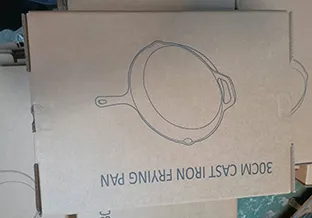
cast iron grill marks press
The Art of Cooking Perfecting Cast Iron Grill Marks
Grilling is an age-old cooking technique that brings out the rich flavors of meat, vegetables, and even fruits. One of the defining characteristics that elevate grilled dishes is the presence of beautiful grill marks. When it comes to achieving those perfect lines, cast iron grill pans are the ideal tool for the job. Let’s explore how to utilize cast iron grill pans effectively to achieve restaurant-quality grill marks and enhance your culinary experience.
The Benefits of Cast Iron
Cast iron has been a beloved kitchen staple for centuries, known for its durability, heat retention, and even cooking surface. When used as a grill, it can reach high temperatures, allowing for those coveted sear marks. The heavy material ensures that heat is distributed consistently, which is crucial for achieving the perfect sear on meats and vegetables alike.
Moreover, cast iron’s natural non-stick properties improve over time with proper seasoning, making it easier to release food without tearing the surface. Unlike other grill methods, cast iron also allows for indoor grilling, offering year-round accessibility regardless of the weather outside.
Preparing Your Cast Iron Grill
Before you even think about placing food on your grill, it’s essential to prepare the cast iron surface properly. Start by preheating the grill pan on medium-high heat for about 5–10 minutes. This heat allows the pan to reach the ideal temperature needed to create those distinctive sear marks.
Additionally, it’s crucial to season the grill. Properly seasoned cast iron helps prevent food from sticking and contributes to that golden-brown crust we all crave. Apply a light coat of oil with a high smoke point (such as canola or grapeseed oil) to the grill before cooking. This keeps your food from sticking and enhances flavor.
cast iron grill marks press

Placement and Timing
Achieving perfect grill marks is an art that involves both placement and timing. Start by placing your protein or vegetables diagonally across the grates of the cast iron grill. This diagonal placement typically results in the most aesthetically pleasing crosshatch marks. After about 2-3 minutes, rotate your food 90 degrees to create the desired crosshatch pattern, then flip it over after another 2-3 minutes.
The timing may vary depending on the thickness of the item you’re grilling. Burgers usually require about 6-8 minutes total for medium doneness, while veggies can vary from 3-10 minutes depending on size and type. Always use a meat thermometer for accuracy, ensuring safety and the perfect level of doneness.
Cleaning and Maintaining Your Cast Iron Grill
Once you’ve finished grilling, cleaning your cast iron grill appropriately is vital for its durability and longevity. Allow the pan to cool slightly before rinsing it with warm water. A non-abrasive sponge will help remove food particles while maintaining the seasoning. Avoid soap, as it can strip the seasoning; instead, opt for a sprinkle of coarse salt if needed.
Dry the grill thoroughly to prevent rusting, and apply a thin layer of oil before storing it. This practice not only preserves the seasoning but also ensures it’s ready for your next grilling adventure.
Conclusion
Mastering the art of achieving perfect cast iron grill marks is both a skill and a science. With proper preparation, thoughtful timing, and the right technique, anyone can create mouthwatering dishes that are visually stunning and flavorful. Whether you’re grilling steaks for a summer BBQ or sautéing vegetables for a cozy indoor dinner, cast iron grill pans offer a versatile and reliable option for all your grilling needs. Embrace this timeless cooking method and let your culinary creations shine with those beautiful grill marks!
-
Season Cast Iron Perfectly with GPT-4 Turbo TipsNewsAug.01,2025
-
High Quality Cast Iron Cookware - Baixiang County Zhongda MachineryNewsAug.01,2025
-
Premium Cast Iron Pan: Durable & Perfect HeatNewsAug.01,2025
-
High Quality Kitchen Durable Black Round Cast Iron Cookware Pancake Crepe Pan-Baixiang County Zhongda Machinery Manufacturing Co., Ltd.NewsAug.01,2025
-
Cast Iron Cookware - Baixiang County Zhongda Machinery | Nonstick, Heat ResistanceNewsAug.01,2025
-
High Quality Kitchen Durable Black Round Cast Iron Cookware - Baixiang County Zhongda Machinery | Non-Stick, Heat Retention, DurableNewsJul.31,2025


